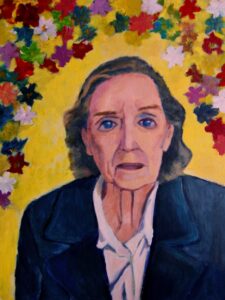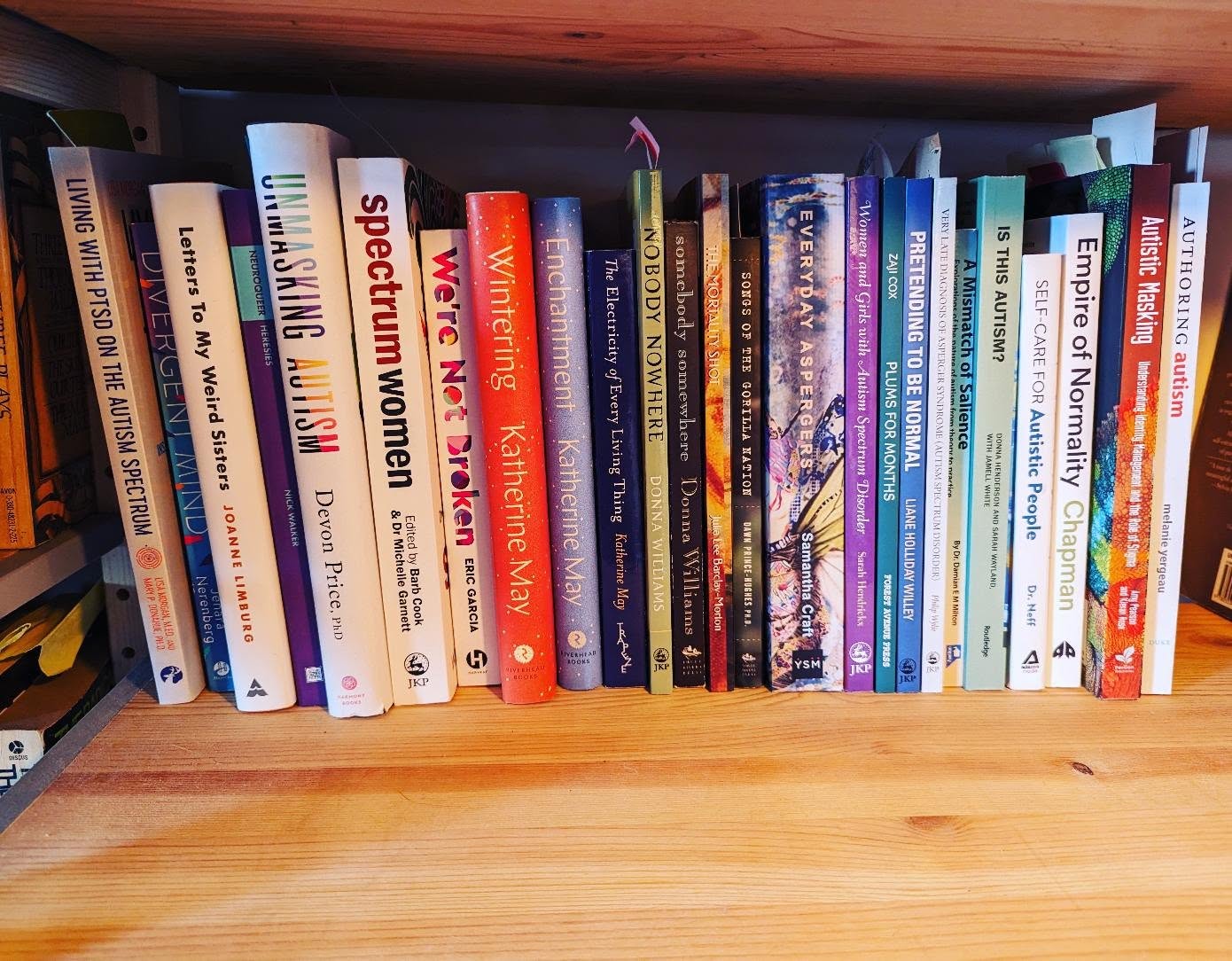
JULIA LEE BARCLAY-MORTON – YOGA, WATER AND REWRITING AUTISM
I interviewed writer Julia Lee Barclay-Morton about her experience of autism. Julia began as an experimental dramatist in New York, moving to the UK to


I first met artist Aya Hastwell at her exhibition ‘Invisible People’. I asked Aya about her growth as an artist and how she works on portraits of people who have been marginalised.
Leslie: Can you tell us, please, about the portraits you recently exhibited of elderly people, carers and people with mental health issues?
Aya: In 2013 I decided to do a series of portraits of the Service Users at Guideposts. A major reason why I started volunteering at Guideposts, by the way, was that my son is bipolar. I became a staff member a few months ago,
I suggested the portraits idea to the art group members I was working with and asked them to contribute to the project by designing and painting a background for their own portrait. The background had to reflect their personality, be it related to their mental health issue or to their memories or families, etc.

As a result of the collaboration with the Service Users, I was able to paint 13 portraits that I exhibited at the graduation show at the Art Academy under the title ‘Invisible People’. The purpose of the project was to increase awareness of people with mental health problems, to show that they are equal members of society and to show their daily struggle with illness and disability. Later the portraits were exhibited at Guideposts and then at Watford Museum, where I’ve been asked to donate the portraits to the Museum collection.
In 2014 I became a part-time carer for elderly and disabled people and the experience helped me recognise that these people are another Invisible part of the society. Most of my clients were old ladies in their 80s and 90s and very often they wouldn’t see anyone for days anyone except carers. I also was impressed by the qualities and compassion of my colleagues at care services, though often the media presents a negative image of these carers. The people I met were humble and hard-working, doing their job responsibly even though they are paid a minimum wage.
As a result of my working experience as a carer I decided to extend my project ‘Invisible People’ and paint my clients and colleagues to bring awareness of this group as well. The 2nd part of the project was exhibited at Watford Town Hall at the end of last year, and then the whole project was on display at Watford Museum in February this year.
Leslie: What key experiences in life have influenced how you approach art?

Aya: I wanted to create art since I was a child. In some sense I followed my father’s footsteps. My father studied art at college but then he had to make a choice between art and journalism. He became a journalist but he used his skills as an artist drawing the people he interviewed.
Unfortunately I didn’t have a choice. My Mum died when I was 12 years old, leaving our 40 year-old father with 4 children on his hands. He married again after one year. Our life changed. I left my home of Almaty in Kazakhstan at 16 years old and went to study mathematics at the university in Siberia. I got married when I was 18, had two children at 22 and divorced at 29. After the divorce I came back to Almaty and had to start again. I didn’t have time for art but had to build my life and my career. A few times I tried to start doing art again but there were always another obligations and priorities.
Fortunately, due to working at Citibank, I had the opportunity to move to London in 2006 and, later, to apply for voluntary redundancy. I say ‘fortunately’ because I achieved a lot in this time, my pre-artistic career. Most of what I achieved was about learning and developing as a professional, on a daily basis, step by step, working persistently and continuously. There is a business ethic that I learned from my 10 years at the bank, and artistic knowledge that I learned at college and the London Art Academy. I follow the rules in any field I’m working. It may sound boring, especially when you talk about art, but for me it’s a daily practice, constantly learning, reading and experimenting with various techniques, looking at other artists’ work, and the most important – being honest with yourself, recognising your mistakes and abilities, developing your skills and working persistently. It gives results I believe.
Leslie: How has your family background from Kazakhstan influenced your art?

Aya: All my family are still in Kazakhstan. Living in UK has made me feel distant and isolated from them. When my father died in 2011, I recognised that our family had fallen apart and possibly didn’t exist anymore. It made me think a lot about what is a family and my family in particular: what are the connections between its members and what would happen if my mother still was alive. It was like traveling through time back to those days when we were a happy family.
In 2012 I presented ‘My Family’ project at the graduation show at City Lit in London. The project was an effort to bring memories about my mum and connect her with my daughter, who never met her, and myself. ‘My Family’ triptych represented imaginary scenes of happy family outings. The paintings were done in monochrome to re-create the photograph style of late 60s.

Leslie: Finally, I’d like to take you back to your work Guideposts and ask you how it has developed.
Aya: Currently I facilitate several groups at Guideposts: relaxation, walking group, art group and Club together; I work closely with the Service Users Representatives and I’m also a link-worker for a number of our clients.
I love my job.
ABOUT LESLIE TATE’S BOOKS:

I interviewed writer Julia Lee Barclay-Morton about her experience of autism. Julia began as an experimental dramatist in New York, moving to the UK to

I interviewed Gillean McDougall from Glasgow, who edited the collaborative projects Honest Error (on Charles Rennie Mackintosh and his wife Margaret Macdonald) and Writing the

I interviewed French writer Delphine de Vigan, whose book, No et moi, won the prestigious Prix des libraires. Other books of hers have won a clutch

I interviewed Joanne Limburg whose poetry collection Feminismo was shortlisted for the Forward Prize for Best First Collection; another collection, Paraphernalia, was a Poetry Book Society Recommendation. Joanne

I interviewed Katherine Magnoli about The Adventures of KatGirl, her book about a wheelchair heroine, and Katherine’s journey from low self-esteem into authorial/radio success and
| Cookie | Duration | Description |
|---|---|---|
| cookielawinfo-checkbox-analytics | 11 months | This cookie is set by GDPR Cookie Consent plugin. The cookie is used to store the user consent for the cookies in the category "Analytics". |
| cookielawinfo-checkbox-functional | 11 months | The cookie is set by GDPR cookie consent to record the user consent for the cookies in the category "Functional". |
| cookielawinfo-checkbox-necessary | 11 months | This cookie is set by GDPR Cookie Consent plugin. The cookies is used to store the user consent for the cookies in the category "Necessary". |
| cookielawinfo-checkbox-others | 11 months | This cookie is set by GDPR Cookie Consent plugin. The cookie is used to store the user consent for the cookies in the category "Other. |
| cookielawinfo-checkbox-performance | 11 months | This cookie is set by GDPR Cookie Consent plugin. The cookie is used to store the user consent for the cookies in the category "Performance". |
| viewed_cookie_policy | 11 months | The cookie is set by the GDPR Cookie Consent plugin and is used to store whether or not user has consented to the use of cookies. It does not store any personal data. |